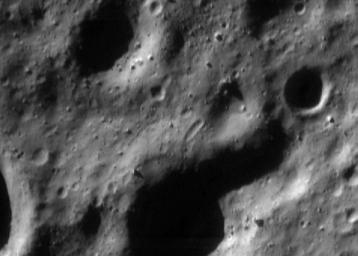
|
Looking Down
- Click the image above for a larger view
- Full-Res JPEG (477 x 342) (22.2 kB)
- Full-Res TIFF (477 x 342) (164.0 kB)
Caption:
NEAR Shoemaker photographs Eros under a variety of lighting and viewing geometries suited to different science objectives. Taken with the Sun high in the sky, images with few shadows are best for mapping the color properties of the surface. Conversely, images taken from directly above a surface with oblique illumination are best for seeing landforms, because shadowing highlights the subtle shape changes on the asteroid's surface.
This image was taken at the latter geometry on May 11, 2000, from an orbital altitude of 52 kilometers (33 miles). The whole scene is about 1.8 kilometers (1.1 miles) across, and shows features as small as 4 meters (13 feet). The rounded nature of the landforms results from formation of small impact craters over the eons. Sharp topography is eroded away by this process, and the surface is blanketed and smoothed by the fragmental debris, or "regolith." The large boulders scattered throughout the scene are the largest fragments of the rocky regolith.
Background Info:
Built and managed by The Johns Hopkins University Applied Physics Laboratory, Laurel, Maryland, NEAR was the first spacecraft launched in NASA's Discovery Program of low-cost, small-scale planetary missions. See the NEAR web page at http://near.jhuapl.edu/ for more details.
Cataloging Keywords:
| Name | Value | Additional Values |
|---|---|---|
| Target | 433 Eros | |
| System | Near Earth Objects | |
| Target Type | Asteroid | |
| Mission | NEAR Shoemaker | |
| Instrument Host | NEAR Shoemaker | |
| Host Type | Orbiter | |
| Instrument | Multi-Spectral Imager (MSI) | |
| Detector | ||
| Extra Keywords | Crater, Grayscale, Impact, Shadow | |
| Acquisition Date | ||
| Release Date | 2000-06-10 | |
| Date in Caption | 2000-05-11 | |
| Image Credit | NASA/JPL/JHUAPL | |
| Source | photojournal.jpl.nasa.gov/catalog/PIA02909 | |
| Identifier | PIA02909 | |
